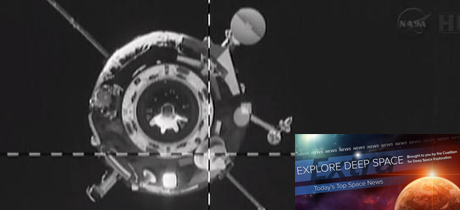In Today’s Deep Space Extra… Russian Progress cargo reaches Space Station. Mars 2020 team adds 4th candidate to landing site. Mars dust storms may finally be calming down.
Human Space Exploration
Progress freighter completes fastest-ever trip to International Space Station
Spaceflightnow.com (7/9): The third time was a charm for Russia late Monday as it launched and docked an automated Progress cargo capsule with nearly three tons of propellant and supplies to the International Space Station. The linkup occurred at 9:31 p.m., EDT, less than four hours after a liftoff from the Baikonur Cosmodrome in Kazakhstan. After further cargo missions, the short transit may be adopted for Russian Soyuz crew launches to the Space Station. Normally, the crew and cargo missions can take six hours or two days.
Russian editor: Our space program is entering the “Dark Ages”
Coalition Member in the News – Boeing
Ars Technica (7/9): Where is Russia’s once venerable space program headed? Hundreds of millions of dollars from NASA’s budget once spent on astronaut transportation aboard Soyuz rockets could soon disappear with the coming emergence of NASA’s Commercial Crew Program and its Boeing and SpaceX partners with their CST-100 Starliner and Dragon 2 spacecraft. The Russian Proton rocket, long a commercial as well as government launch vehicle success, is being phased out. Can its replacement, the Angara family of rockets, keep up with innovative U.S. competitors? Nauka, an aging Russian science module, continues to await a decision on whether to launch it to the International Space Station. This year, Russia cut its Space Station staffing from three to two cosmonauts to restrict costs. These are not the best of times for Russia’s space program, according to a summary compiled from an assessment by a Russian science and technology editor.
Space Science
Mars 2020 rover team adds 4th candidate to landing-site list
Space.com (7/9): A candidate called Midway has been added to the short list of possible landing sites under consideration for NASA’s Mars 2020 mission, a rover that is to gather and cache rock and soil samples for return to Earth with a second mission now being formulated by NASA and the European Space Agency. Other landing sites under consideration are Columbia Hills, Jezero Crater and NE Syrtis. All four are believed to host possible evidence of past or current Martian life. Further deliberations are planned by NASA in mid-October. The Mars 2020 launch is planned for mid-2020.
Life on Mars could have gotten an early start, ‘Black Beauty’ meteorite suggests
Space.com (7/9): Perhaps as soon as 20 million years after the solar system formed, Mars had cooled enough to have a crusty surface stable enough to support an ocean and perhaps life. Those are conclusions from a new study of a small Mars meteorite known as “Black Beauty,” which was discovered in the Sahara Desert in 2011. The study was published by the journal Nature.
NASA: Mars dust storm may finally be calming down
CNET (7/9): The global dust storm that stirred up on Mars in May might have reached its peak, good news for a small community of spacecraft in orbit and on the surface of the Red Planet, among them NASA’s Opportunity rover, which has been the surface for more than 14 years. Opportunity has been silenced by the storm.
Universe Today (7/8): There may be an alternative to the challenge of developing and launching large powerful space observatories, like the James Webb Space Telescope (JWST), according to a pair of researchers at the University of New Mexico. An alternative might be devising squadrons of small telescope designed to align and work closely together in space.
Other News
Israeli lunar landing planned for 2019
Arutz Sheva of Israel (7/10): Israel will attempt to join the U.S., Russia and China as the only nations to achieve a lunar landing. Israel’s SpaceIL plans to launch its lander from the U.S. in late December atop a SpaceX Falcon 9 launch vehicle. The landing is planned for February 13. Mission activities for the 400 pound lander are not described.
The Space Review (7/9): Apollo 12 astronaut Alan Bean saw himself as an ordinary person who could do the extraordinary, like stroll on the moon, because he didn’t quit trying. Bean, who died on May 26 at the age of 86, went on to become a painter, an artist recognized for his love of spaceflight with skills for getting along with others.
Neil Armstrong’s sons, filmmakers discuss making ‘First Man’
Collectspace.com (7/9): First Man a film drama of the life of Apollo 11 commander Neil Armstrong opens October 12 in U.S. theaters. Two of Armstrong’s sons, Rick and Mark, joined a Phoenix SpaceFest discussion of the script and the making of the film on July 7. Apollo 11’s Armstrong and Buzz Aldrin became the first humans to walk the surface of another planetary body on July 20, 1969.

